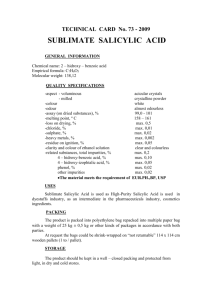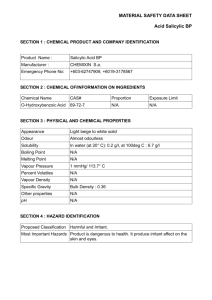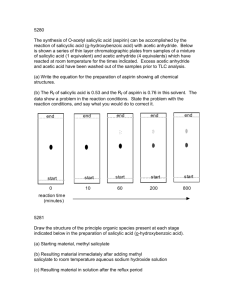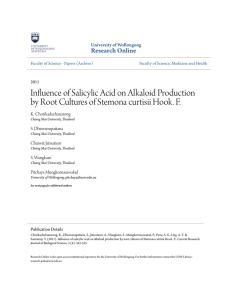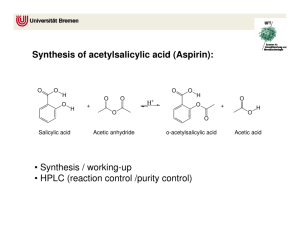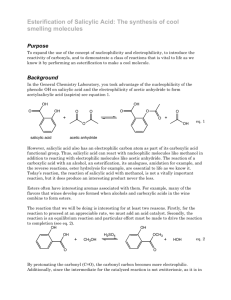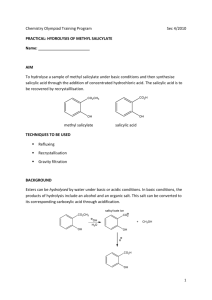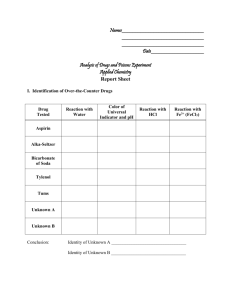Current Research Journal of Biological Sciences 3(4): 322-325, 2011 ISSN: 2041-0778
advertisement
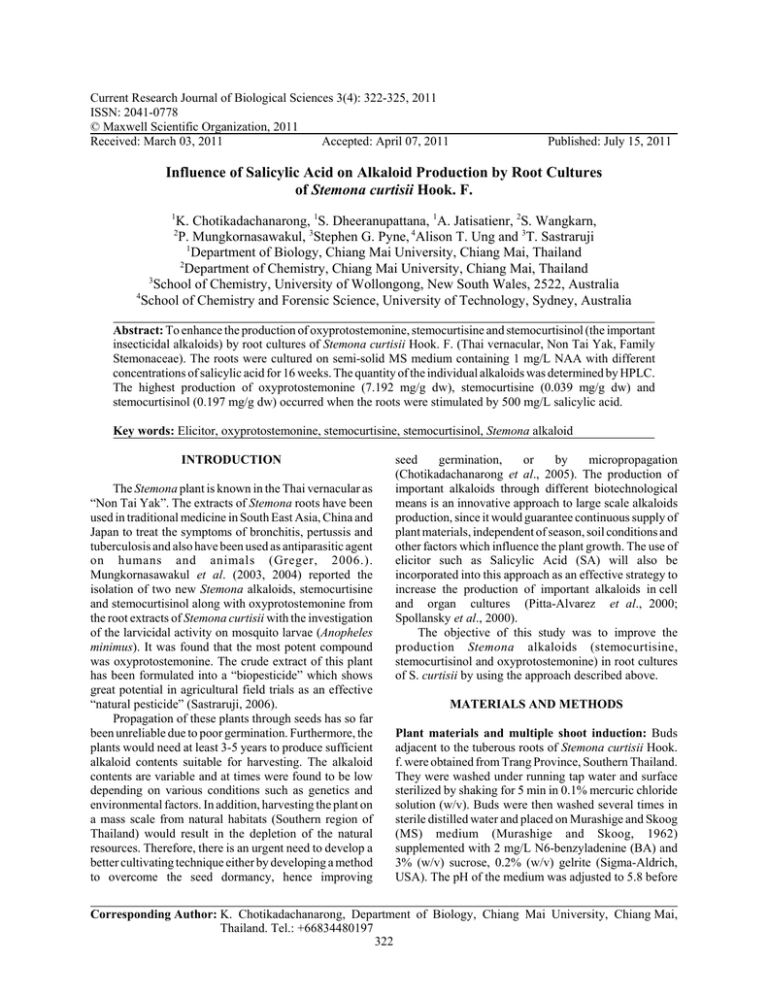
Current Research Journal of Biological Sciences 3(4): 322-325, 2011 ISSN: 2041-0778 © Maxwell Scientific Organization, 2011 Received: March 03, 2011 Accepted: April 07, 2011 Published: July 15, 2011 Influence of Salicylic Acid on Alkaloid Production by Root Cultures of Stemona curtisii Hook. F. 1 K. Chotikadachanarong, 1S. Dheeranupattana, 1A. Jatisatienr, 2S. Wangkarn, P. Mungkornasawakul, 3Stephen G. Pyne, 4Alison T. Ung and 3T. Sastraruji 1 Department of Biology, Chiang Mai University, Chiang Mai, Thailand 2 Department of Chemistry, Chiang Mai University, Chiang Mai, Thailand 3 School of Chemistry, University of Wollongong, New South Wales, 2522, Australia 4 School of Chemistry and Forensic Science, University of Technology, Sydney, Australia 2 Abstract: To enhance the production of oxyprotostemonine, stemocurtisine and stemocurtisinol (the important insecticidal alkaloids) by root cultures of Stemona curtisii Hook. F. (Thai vernacular, Non Tai Yak, Family Stemonaceae). The roots were cultured on semi-solid MS medium containing 1 mg/L NAA with different concentrations of salicylic acid for 16 weeks. The quantity of the individual alkaloids was determined by HPLC. The highest production of oxyprotostemonine (7.192 mg/g dw), stemocurtisine (0.039 mg/g dw) and stemocurtisinol (0.197 mg/g dw) occurred when the roots were stimulated by 500 mg/L salicylic acid. Key words: Elicitor, oxyprotostemonine, stemocurtisine, stemocurtisinol, Stemona alkaloid INTRODUCTION The Stemona plant is known in the Thai vernacular as “Non Tai Yak”. The extracts of Stemona roots have been used in traditional medicine in South East Asia, China and Japan to treat the symptoms of bronchitis, pertussis and tuberculosis and also have been used as antiparasitic agent on humans and animals (Greger, 2006.). Mungkornasawakul et al. (2003, 2004) reported the isolation of two new Stemona alkaloids, stemocurtisine and stemocurtisinol along with oxyprotostemonine from the root extracts of Stemona curtisii with the investigation of the larvicidal activity on mosquito larvae (Anopheles minimus). It was found that the most potent compound was oxyprotostemonine. The crude extract of this plant has been formulated into a “biopesticide” which shows great potential in agricultural field trials as an effective “natural pesticide” (Sastraruji, 2006). Propagation of these plants through seeds has so far been unreliable due to poor germination. Furthermore, the plants would need at least 3-5 years to produce sufficient alkaloid contents suitable for harvesting. The alkaloid contents are variable and at times were found to be low depending on various conditions such as genetics and environmental factors. In addition, harvesting the plant on a mass scale from natural habitats (Southern region of Thailand) would result in the depletion of the natural resources. Therefore, there is an urgent need to develop a better cultivating technique either by developing a method to overcome the seed dormancy, hence improving seed germination, or by micropropagation (Chotikadachanarong et al., 2005). The production of important alkaloids through different biotechnological means is an innovative approach to large scale alkaloids production, since it would guarantee continuous supply of plant materials, independent of season, soil conditions and other factors which influence the plant growth. The use of elicitor such as Salicylic Acid (SA) will also be incorporated into this approach as an effective strategy to increase the production of important alkaloids in cell and organ cultures (Pitta-Alvarez et al., 2000; Spollansky et al., 2000). The objective of this study was to improve the production Stemona alkaloids (stemocurtisine, stemocurtisinol and oxyprotostemonine) in root cultures of S. curtisii by using the approach described above. MATERIALS AND METHODS Plant materials and multiple shoot induction: Buds adjacent to the tuberous roots of Stemona curtisii Hook. f. were obtained from Trang Province, Southern Thailand. They were washed under running tap water and surface sterilized by shaking for 5 min in 0.1% mercuric chloride solution (w/v). Buds were then washed several times in sterile distilled water and placed on Murashige and Skoog (MS) medium (Murashige and Skoog, 1962) supplemented with 2 mg/L N6-benzyladenine (BA) and 3% (w/v) sucrose, 0.2% (w/v) gelrite (Sigma-Aldrich, USA). The pH of the medium was adjusted to 5.8 before Corresponding Author: K. Chotikadachanarong, Department of Biology, Chiang Mai University, Chiang Mai, Thailand. Tel.: +66834480197 322 Curr. Res. J. Biol. Sci., 3(4): 322-325, 2011 Table 1: Effects of salicylic acid on root growth and alkaloids production Alkaloid content ---------------------------------------------------------------------------------------------------------------------------------------------------------------------------------------------------------------------Root Oxyprotostemonine (mg/g dw) Stemocurtisine (mg/g dw) Stemocurtisinol (mg/g dw) growth ---------------------------------------------------------------------------------------------------------------------------------------------------------------------------------------------------(g dw) Root extract Media extract Total Root extract Media extract Total Root extract Media extract Total 0.535±0.009f 0.345±0.00389a 0.345±0.0039a 0.243±0.0028a 0.243±0.0028a Intact 0.535±0.009e root Control 0.363±0.028a 2.927±0.019a 0 2.927±0.019e 0.001±0.00001cd 0 0.001±0.0001e 0.036±0.0004b 0 0.036±0.0004e Salicylic acid (mg/L) 100 0.199±0.026a 2.696±0.031b 1.945±0.022d 4.677±0.029b 0.001±0.00001c 0.006±0.0006b 0.008±0.0001de 0.034±0.0004b 0.054±0.0006c 0.088±0.0009c 200 0.235±0.022a 1.195±0.014c 2.554±0.029c 3.765±0.030d 0.003±0.00037bc 0.006±0.0008b 0.010±0.0001c 0.022±0.0002e 0.024±0.0002d 0.046±0.0004d a d b c bc b e f b 300 0.214±0.021 0.726±0.008 3.223±0.037 3.959±0.037 0.002±0.00021 0.002±0.0002 0.004±0.0001 0.013±.0001 0.068±0.0007 0.081±0.0008c 500 0.224±0.024a 0.275±0.003f 6.913±0.079a 7.192±0.138a 0.012±0.00369b 0.027±0.0031a 0.039±0.0004b 0.036±0.0003d 0.161±0.0018a 0.197±0.0021b Values showed the mean ± standard error in a column followed by similar letters do not differ significantly at p<0.05 autoclaving at 121ºC for 15 min. Cultures were incubated at 25±2ºC under 16 h/d photoperiods. Multiple shoots were induced from the buds explants after 2-3 months of culturing showed extensive proliferation. Shoot explants were placed on the root culture medium, MS medium supplemented with 1 mg/L naphthalene acetic acid (NAA) and solidified with 0.2% (w/v) gelrite at 25±2ºC, under 16 h/d photoperiods. Roots were generated after culturing for 3 months. Addition of salicylic acid: Salicylic acid (SigmaAldrich, Germany) concentration 100, 200, 300 and 500 mg/L was added to the MS medium to an appropriate concentration and the pH was adjusted to 5.8 before autoclaving. Roots (1 g fresh weight) were inoculated into elicitation medium and control medium (without SA addition) for 16 weeks at 25ºC, with 16 h photoperiod (2000 lux, cool white fluorescent tubes). After 16 weeks of elicitation roots were collected and the fresh weight was determined. The roots were then dried with venticell at 35ºC. After total elimination of water was achieved, the dried roots were weighed and the alkaloid content was determined by HPLC. working standard solutions containing oxyprotostemonine, stemocuurtisine and stemocurtisinol in the concentration range of 0.164-10.516, 0.001-0.128 and 0.001-0.200 mg/L were prepared, respectively. The analysis of these compounds were performed using an Agilent 1100 HPLC system equipped with UV detector at wavelength of 297 nm (Agilent Technologies, Palo Atto, CA, USA). 20 :L of solution was injected onto reversed phased (Inertsil ODS-3, 5 :m, 4.6 I.D. × 150 mm, GL sciences Inc., Japan). HPLC column and eluted at flow rate 1.0 mL/min with methanol (Merck, HPLC grade, Germany)-Milli-Q water (60:40, v/v). Prior to the next run, the HPLC column was equilibrated further for 30 min. Data acquisition and analysis were performed by the Agilent ChemStation software. The retention times of oxyprotostemonine, stemocurtisine and stemocurtisinol were 2.37, 4.15 and 7.67 min, respectively. Root extract: Dried root powder (1 g) was macerated sequentially with 3×50 mL methanol (Merck, HPLC grade, Germany) at room temperature over 3 days. The methanol solution (150 mL) was filtered and evaporated at 35ºC. Then the crude methanol extract was dissolved in 1 mL methanol and 1 mL water before extraction with dichloromethane (3×5 mL) to give the partially purified extract. The weight was recorded. The extract was analyzed by HPLC. Statistical analysis: All experiments were repeated at least thrice with 15 replicates per treatment. All the values are expressed as the mean±SE. The data was analyzed by using one-way analysis of variance (ANOVA) followed by Turkey’s test, p<0.05 was considered statistically significant. Medium extract: The medium was extracted with dichloromethane (Merck, HPLC grade, Germany) at a ratio of medium: dichloromethane of 1:1 (3 times). The dichloromethane fraction was separated and filtered before evaporated at 35ºC to give the partially purified extract. The weight was recorded. The extract was analyzed by HPLC. The effects of SA on root growth and production of oxyprotostemonine, stemocurtisine and stemocurtisinol: A comparison was made between cultures treated with SA and controlled cultures of the root growth and oxyprotostemonine, stemocurtisine and stemocurtisinol production. SA was added on the first day of the culture period and the effects were observed at 16th week (4 months). Figure 1 shows the effects of SA on root growth. In this experiment, salicylic acid had a negative effect on root growth. All concentration of SA slightly decreased root growth compared to the control (Table 1) and stimulation root browning. Research location: All experiments were conducted at Plant Tissue Culture Laboratory, Department of Biology, Faculty of Science, Chiang Mai University, Chiang Mai, Thailand for 1 year (January 2010 - January 2011). RESULTS AND DISCUSSION High-Performance Liquid Chroma-tography (HPLC) Analysis of Alkaloids from the Roots and the Exudates: Quantification was based on the external standard method using calibration curves. The mixed 323 Curr. Res. J. Biol. Sci., 3(4): 322-325, 2011 0.40 Root growth (g dw) Root growth (g dw) 0.30 0.35 Stemocurtisinol (mg/g dw) Root extract Media extract 0.25 0.30 0.25 0.20 0.20 0.15 0.15 0.10 0.05 0.10 0.00 Control Salicylic acid 100 mg/L Salicylic acid 200 mg/L Salicylic acid 300 mg/L Salicylic acid 500 mg/L 0.05 0.00 Intact root Fig. 1: Effects of salicylic acid on root growth 8 7 6 Oxyprotosteminine (mg/g dw) Root extract fact that SA is the one of key endogenous signals involved in the activation of numerous plant defense responses (Shah et al., 1999), As previously reported that an elicitor could be highly selective stimulating the metabolite synthesis, for example, causing the enhancement of monomeric over than dimeric alkaloids in Catharanthus roseus (Aerts et al., 1996). SA and its chemical derivative such as acetylsalicylic acid can also enhance the productivity of some secondary metabolites in plant tissues and in cell cultures. In a suspension culture of Hyoscyamus muticus treated with 40 mM SA, the production of lubimin increased by 50%, while in a transformed root culture of the same species, solavetivone production increased by 48% following the addition of 4 mM SA (Mehmetoglu and Curtis, 1997). Furthermore, a 505% increase in total alkaloid production was achieved by adding 1 mM SA to tumor lines of C. roseus cultured in vitro (Gergorio and Victor, 1997). The releasing mechanism is not yet clear. Some researchers have been investigating the factors involve in vacuolar phytochemical storage. The accumulation of indole alkaloids in C. roseus vacuoles has been attributed to an ion-trap mechanism, whereby the basic indole alkaloids are trapped in the acidic vacuole due to their positive charge at low pH, preventing diffusion across the tonoplast (Neumann et al., 1983). Studies carried out with suspension cultures of Catharanthus roseus, (producers of indole alkaloids) led to the proposal of an ‘ion-trapping’ mechanism of alkaloids in the vacuoles, involving their passive diffusion in the neutral state from the cytoplasm towards the vacuoles, where they would be charged and maintained trapped. These studies revealed that lowering the medium pH, and thus changing the pH gradient between the cells and the medium, would induce the release of alkaloids and their entrapment as ions in the extracellular milieu (Renaudin and Guern, 1990). However, a detailed study of the research for releasing mechanism of S. curtisii root cultures is required. The 5 4 3 2 1 0 Control Salicylic Salicylic Salicylic Salicylic acid 100 acid 200 acid 300 acid 500 mg/L mg/L mg/L mg/L Fig. 2: Effects of salicylic acid on oxyprotostemonine production Stemocurtisine (mg/g dw) Root extract 0.40 Media extract 0.35 0.30 0.25 0.20 0.15 0.10 0.05 0.00 Intact root Control Salicylic Salicylic Salicylic Salicylic acid 100 acid 200 acid 300 acid 500 mg/L mg/L mg/L mg/L Fig. 4: Effects of salicylic acid on stemocurtisinol production Media extract Intact root Control Salicylic Salicylic Salicylic Salicylic acid 100 acid 200 acid 300 acid 500 mg/L mg/L mg/L mg/L Fig. 3: Effects of salicylic acid on stemocurtisine production Figure 2 and Table 1 shows the content of oxyprotostemonine in the root and media extracts after adding various concentrations of SA for 4 mouths. Increasing SA concentrations decreased oxyprotostemonine accumulation in the root whereas; in the media it had a positive effect on stimulating its secretion which enhanced oxyprotostemonine accumulation in the media. The positive responses of the root cultures to elicitation are possibly associated with the 324 Curr. Res. J. Biol. Sci., 3(4): 322-325, 2011 highest significant increase total oxyprotostemonine content (7.192 mg/g dw, 2.46 fold higher than that of the control and 13.44 fold than that of the intact roots) was observed in cultures treated with 500 mg/L SA. Effects of SA on stemocurtisine production are shown in Fig. 3 and Table 1. Similar to the oxyprotostemonine production results, treatment with exogenous SA also increased the production of stemocurtisine and the release of this metabolite into the culture medium. Increasing salicylic acid concentration decreased stemocurtisine content in the root but increased the release of stemocurtisine into the cultured media. Treatment with 500 mg/L SA resulted in a significant increase in total stemocurtisine content (0.039 mg/g dw) up to about 39 fold higher than that of the control. However stemocurtisine production was overall 9 fold less than that found in the intact root. Effects of SA on stemocurtisinol production were investigated and the results are shown in Fig. 4 and Table 1. Similar to the stemocurtisine production results, treatment with exogenous SA had a positive effect on production of stemocurtisinol and the release of this metabolite into the culture medium. Treatment with 500 mg/L SA has significantly increased the total stemocurtisinol content (0.197 mg/g dw) up to about 5.47 fold higher than that of the control. However stemocurtisinol production was overall 1.23 fold less than that found in the intact root. Chotikadachanarong, K., S. Dheeranupattana and A. Jatisatienr, 2005. Micropropagation and alkaloid production in Stemona sp. Acta Hort., 676: 67-72. Gergorio, G.H. and M.L.V. Victor, 1997. Effect of acetylsalicylic acid on secondary metabolism of Catharanthus roseus tumor suspension cultures. Plant Cell Rep., 16: 287-290. Greger, H., 2006. Structural relationships, distribution and biological activities of Stemona alkaloids, Planta Medica., 72: 99-113. Mehmetoglu, U. and W.R. Curtis, 1997. Effects of abiotic inducers onsesquiterpene synthesis in hairy root and cell-suspension cultures of Hyoscyamus muticus. Appl. Biochem. Biotechnol., 67: 71-77. Mungkornasawakul, P., S.G. Pyne, A. Jatisatienr, D. Supyen, C. Jatisatienr, W. Lie, A.T. Ung, B.W. Skelton and A.H. White, 2004. Phytochemical and larvicidal studies on Stemona curtisii: Structure of a new pyrido[1,2-a]azepineStemona alkaloid. J. Nat. Prod., 67: 675-677. Mungkornasawakul, P., S.G. Pyne, A. Jatisatienr, D. Supyen, W. Lie, A.T. Ung, B.W. Skelton and A.H. White, 2003. Stemocurtisine, the first pyrido[1,2-a]azepine Stemona alkaloid. J. Nat. Prod., 66: 980-982. Murashige, T. and F. Skoog, 1962. A revised medium for rapid growth and bioassays with tobacco cultures. Physiol. Plant, 15: 473-497. Neumann, D.G., G. Krauss, M. Hieke and D. Groger, 1983. Indole alkaloid formation and storage in cell suspension cultures of Catharanthus roseus. Planta Med., 48: 20-23. Pitta-Alvarez, S.I., T.C. Spollansky and A.M. Giulietti, 2000. The influence of different biotic and abiotic elicitors on the production and profile of tropane alkaloid in hairy root cultures of Brugmansia candida. Enzyme Microb. Technol., 26: 252-258. Renaudin, J.P. and J. Guern, 1990. Transport and Vacuolar Storage of Secondary Metabolites in Plant Cell Cultures. In: Charlwood, B.V. and M.J.C. Rhodes (Eds.), Secondary Products from Plant Tissue Cultures. Clarendon Press, Oxford, pp: 59-78. Sastraruji, T., 2006. Bioinsecticide production from Stemona extract and its application in agricultural use. Ph.D. Thesis, Chiang Mai University, pp: 145. Shah, J., P. Kachroo and D.F. Klessig, 1999. The Arabidopsis ssi I mutation restores pathogenesis related gene expression in npr I plants and renders defensive gene expression salicylic acid dependent. Plant Cell, 11: 191-206. Spollansky, T.C., S.I. Pitta-Alvarez and A.M. Giulietti, 2000. Effect of jasmonic acid and aliminium on production of tropane alkaloids in hairy root cultures of Brugmansia candida. Plant Biotechnol., 3: 1-3. CONCLUSION The results suggest that applying the elicitor SA at 500 mg/L salicylic acid for 16 weeks to S. curtisii root cultures results in a significant increase in the amount of total oxyprotostemonine (7.192 mg/g dw, 13.443 folds higher than intact root), stemocurtisine (0.039 mg/g dw, 39 folds higher than control) and stemocurtisinol (0.197 mg/g dw, 5.47 folds higher than control) However only oxyprotostemonine production was higher than that found in the intact roots where oxyprotostemonine is only the minor alkaloid component. ACKNOWLEDGMENT Chotikadachanarong, K., would like to thank the Office of the Higher Education Commission, Thailand for supporting the grant funded under the program Strategic Scholarships for Frontier Research Network for the Ph.D. Program Thai Doctoral degree for this research and support from the Graduate School, Chiang Mai University, Chiang Mai, Thailand. REFERENCES Aerts, R.J., A. Schaefer, M. Hesse, T.W. Baumann and A. Slusarenko, 1996. Signalling molecules and the synthesis of alkaloids in Catharanthus roseus seedlings. Phytochem., 42: 417-422. 325
